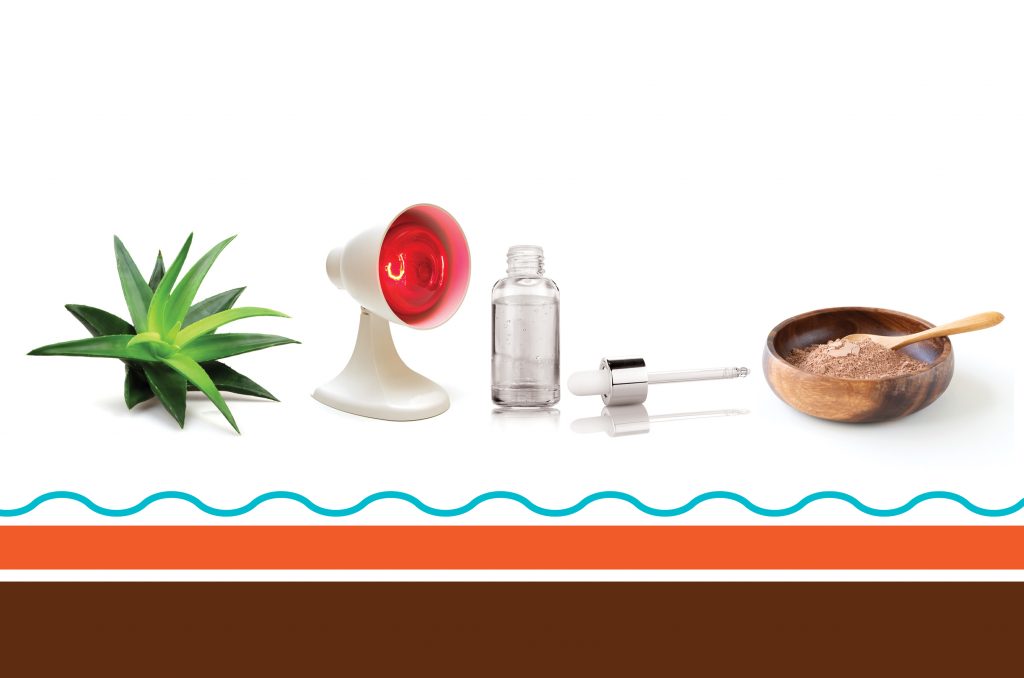When it comes to skin care, there’s always something trending. Whether it’s a tried and true ingredient experiencing a resurgence in popularity or an innovative new therapy making a splash, it can be tricky to keep track of everything. We’re breaking down four skin care treatments that are having a moment, so you can feel confident about what you put on your skin.
We all know that aloe vera is super useful for soothing sunburns, but its skin care uses are vast. There are more than 420 species of aloe vera plants, and the one mostly commonly used to treat skin conditions is aloe barbadensis Miller. The plant is excellent at treating minor burns because of a natural compound called aloin, which has anti-inflammatory and antioxidant properties. Since it’s anti-inflammatory and also antimicrobial, it also can be used to treat acne. When you pick up an aloe vera gel at the drugstore, it’s often combined with other soothing ingredients like echinacea and calendula.
Aloe vera also contains aloesin, a compound that has been shown to effectively treat dark spots caused by exposure to ultraviolet light as well as other forms of hyperpigmentation. Sugars found in the plant called mucopolysaccharides help retain moisture, leading to healthier, more hydrated skin. Replenishing moisture in the skin helps fight off visible signs of aging like fine lines and wrinkles. Aloe vera has further anti-aging benefits because it stimulates the production of hyaluronic acid, collagen and elastin fibers, which all play a part in keeping the skin supple and firm.
This treatment uses low-intensity red light to stimulate skin cells to trigger them to respond to damage and rejuvenate themselves. It is used to treat skin conditions like wrinkles, scars, stretch marks, psoriasis and persistent wounds. The process is thought to work by increasing the function of the mitochondria in skin cells, allowing for increased energy inside the cells. While laser treatments work by creating controlled damage to the outer layer of the skin, red light therapy penetrates below the skin’s surface and does not cause damage. Because the light is specially calibrated, unlike with sunlight, there also is no risk of skin cancer with exposure.
When visiting a skin care professional, red light therapy is often used as an add-on for more in-depth procedures like medical facials, microdermabrasion and microneedling because it can help speed along the healing process. In-office devices are stronger than those that are available for use at home, such as red light masks. However, home devices can be used to maintain results from professional treatments, and thanks to repeated use, they can help achieve better outcomes.
Found naturally in wheat, rye and barley, azelaic acid is a common treatment for acne and rosacea because it soothes inflammation. It also can unclog pores thanks to its antibacterial and antioxidant properties. Azelaic acid is a more gentle exfoliant than other alpha hydroxy acids, such as glycolic, lactic and mandelic acids, and it won’t leave your skin more sensitive to sun exposure unlike other acids. It’s not only gentle, but also versatile as it can also be used to treat hyperpigmentation.
Research has found that a prescription-strength azelaic acid (usually 15 to 20%) can decrease mild to moderate acne by around 53% after 12 weeks. Over-the-counter creams, gels and foams also are available and have a lower strength of around 10% or less. Azelaic acid is gentle enough to use twice a day. However, if you have sensitive skin, you may want to gradually introduce it into your skin care routine. While it is a mild acid and adverse reactions are uncommon, slight irritation can occur, and more severe side effects like swelling and hives may indicate an allergy.
You may not have realized it, but calcium bentonite clay has been a staple of skin care for decades. It is very common in face masks, but you also can find it in cleansers and scrubs. However, don’t mix it up with sodium bentonite clay, which is used as sealant for lakes and ponds and shouldn’t be used on the skin. Derived from volcanic ash, bentonite clay is known for its purifying and acne-fighting properties thanks to its ability to soak up excess oil and remove impurities. It binds to dirt, oil and other pollutants on the skin’s surface and absorbs them.
Bentonite clay is a good option for people with oily or acne-prone skin. It contains antioxidant minerals called phyllosilicates that can soothe the inflammation of breakouts. You can create your own mask using a bentonite clay powder or premixed products also are available. When using a mask, make sure you remove it before it hardens and starts to flake. While wet, the clay soothes the skin and soaks up oil, but as it dries, it may dehydrate and irritate the skin. As part of an acne regimen, consider applying a mask two or three times a week. However, if you have sensitive skin, start with once a week to see if it causes irritation.
